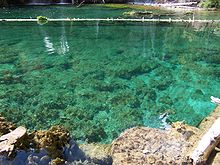Hanging Lake
| Hanging Lake | |
|---|---|
| Location | Glenwood Canyon, Colorado |
| Coordinates | 39°36′06″N 107°11′31″W / 39.6016497°N 107.1919967°W |
| Basin countries | United States |
Hanging Lake is a lake in the U.S. State of Colorado. It is located in Glenwood Canyon, about 7 miles east of Glenwood Springs, Colorado and is a very popular tourist destination. The lake is reached via a trailhead located near I-70 in the bottom of the canyon. The trail follows Dead Horse Creek, a tributary of the Colorado River and ascends some 1,000 feet.[1]



History
Early tales of the discovery of the lake tells of a man searching for gold in the canyon when the Colorado River was called the Grand River. The man found a dead horse at the opening of a gulch (the possible origin of Dead Horse Gulch). When he followed the gulch up through the steep hillside through the canyon he came around the backside of the lake. This is how he first saw the small bowl-like basin hanging onto the cliffs below.
In the years following the area served as a homestead, and a private family retreat until it was purchased by Glenwood Springs after the Taylor Bill was passed by Congress in 1910.[2]
Following the purchase it began its long history as a public tourist stop, and later during the 1940s hosted a resort and cafe until the construction of Interstate-70 began in 1968.
In 1972 the trail and the lake were returned to the protection of the Forest Service as part of the White River National Forest, and has been an increasingly popular tourist destination since.
In 2011 the lake was named a National Natural Landmark by Secretary of the Interior Ken Salazar.[3]
Travertine
The fragile shoreline of Hanging Lake is composed of travertine, created when dissolved limestone from the Mississippian aged Leadville Formation (through which the Dead Horse Creek flows) is deposited on rocks and logs, creating travertine layers.[4]
The oils from human skin speed along the erosion of the travertine so it is suggested that hikers not wade in the water in an effort to help preserve the lake for future generations.
For similar Travertine influenced scenery in Europe see Plitvice Lakes National Park which is a World Heritage Site, .
Hiking The Trail To Get To The Lake
The Hanging Lake trail begins at the end of the bike path which begins at the Hanging Lake Rest Stop (Exit 125 on I-70 EASTBOUND ACCESS ONLY. Visitors coming from Denver must exit at MP 121 and turn around). The bike trail is approximately 1/2 mile in length and raises in elevation approximately 1000 ft .[5]
From there, it is a 1.2 mile climb in what the Forest Service calls a "difficult" trail. Hikers are advised to bring enough water (minimum one liter per hiker is advised, additional on hotter days). The trail is quite steep in some areas areas and requires hikers to traverse very rocky areas. It meanders alongside a stream originating from the lake. There are very few level spots on the trail.[6] Good hiking boots or shoes are a must; and in winter a staff or walking sticks will assist greatly.
See also
References
- ^ Mountain Zone Hanging Lake, Colorado
- ^ The Aspen Times Hanging Lake boasts long history as tourist stop
- ^ http://www.doi.gov/news/pressreleases/AMERICAS-GREAT-OUTDOORS-Secretary-Salazar-Designates-Six-New-National-Natural-Landmarks.cfm "AMERICA’S GREAT OUTDOORS: Secretary Salazar Designates Six New National Natural Landmarks", 6/15/11
- ^ Colorado Outing Hanging Lake
- ^ Hiking in Colorado Hanging Lake
- ^ Visit Glenwood Springs Hiking - Hanging Lake
External links
- Hanging Lake Trail - US Forest Service information and map
- Hanging Lake — a fragile paradise at The Aspen Times
- Hiking in Colorado - Hanging Lake
- Hanging Lake Trail videos and reviews
- Hanging Lake - AllAspen.com - visiting details
